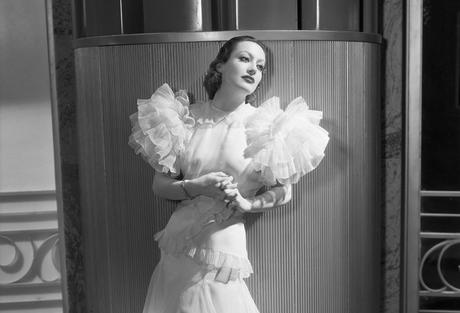
Out of all the stars dubbed “box office poison” by the Independent Theater Owners Association in May 1938, the label has become most strongly associated with Joan Crawford. For the most part, being called “box office poison” ultimately became a footnote in the careers of the stars included on the list. Some moved on from Hollywood, but others stars successfully moved past it and entered into new phases of their careers. But Joan is the only star on the list who, decades later, had an unflattering film made about them which included an infamous scene of them having a breakdown over being named “box office poison.”
For many people, if you mention Joan Crawford, the first thing they’ll think of is Mommie Dearest. More specifically, they might think of the scene with Faye Dunaway in an evening gown, hacking down rose bushes at night while muttering about box office poison. Or they may think of the more recent depiction of Joan in 2017’s Feud: Bette & Joan, which also referenced Joan being named “box office poison.” But long before Mommie Dearest and Feud, Joan was unquestionably one of the top movie stars of the 1930s.
When Joan Crawford arrived in Hollywood after being spotted as a chorus girl, she wasn’t even Joan Crawford just yet. At the time she signed her first contract with MGM in 1924, she was still Lucille LeSeur. She made her film debut in 1925’s Lady of the Night in an uncredited role as a body double for Norma Shearer. While learning the ropes while working as an extra or in small parts, she officially became Joan Crawford after MGM held a contest where people had the chance to name their new, up-and-coming star.

Writer Frederica Sagor Maas is quoted as saying, “Joan Crawford became a star because Joan Crawford decided to become a star.” Having endured a very destitute childhood, Joan fully embraced her new identity and everything that a career in Hollywood had to offer. She threw herself into learning everything she could about the art and the process of making films and worked hard to make a name for herself. By 1926, she was well on her way when she was named a WAMPAS Baby Star, a group that also included Mary Astor, Janet Gaynor, and Dolores Del Rio that same year. In 1927, she had a notable role in The Unknown with Lon Chaney, which she often cited as a pivotal learning experience for her. She became a full-fledged movie star in 1928 after the release of Our Dancing Daughters and in 1929, she married Douglas Fairbanks, Jr., making her part of one of Hollywood’s most storied families.
As the film industry moved into the sound era, Joan easily made the transition and her box office appeal continued to reach new heights. While there were some missteps in the early 1930s, she was a reliably strong box office draw. For example, 1932’s Rain was one movie Joan had a low opinion of because it wasn’t popular with her fans. But even some of the movies that no Joan Crawford fan today would cite as being among her best were still profitable. 1930’s Montana Moon, for instance, took in $960,000 at the box office with a budget of $277,000.
The early 1930s were truly a golden age for Joan’s career. During this time, she had a chance to begin working with one of her best co-stars, Clark Gable, which helped establish him as another one of the biggest stars of the decade. She also had a successful run of movies with Franchot Tone, who became her second husband in 1935. In 1932, she appeared in MGM’s all-star extravaganza, Grand Hotel, which not only reflected her status as a box office draw, but gave her career artistic validation. It had only been four years since she became a star in Our Dancing Daughters and here she was being cast alongside highly respected stars like Greta Garbo, John Barrymore, and Lionel Barrymore.
By the mid-to-late 1930s, Joan had entered an interesting phase of her career. The movies she made between 1935 and 1939 generally aren’t discussed as being among her top tier movies, The Women (1939) being an exception. While some of them, indeed, aren’t among her best, she did make some that I personally think get a bit overlooked in her filmography. And when you start going through each movie she made during that period, you might be surprised to see that the “box office poison” isn’t a particularly accurate way to describe them.
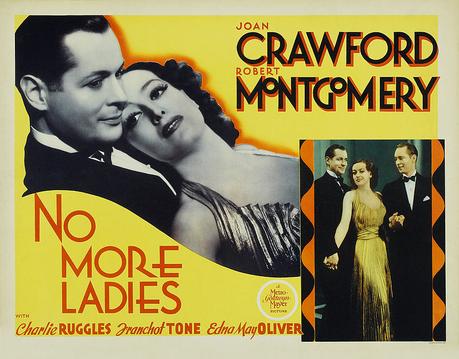
Throughout the early 1930s, Joan was largely known for playing working class women who moved up the social ladder. By the mid-1930s, though, Joan wasn’t being given a whole lot of room to grow. In both of her movies released in 1935, No More Ladies and I Live My Life, she played socialites – a step away from her signature shopgirls and secretaries, but it wasn’t unheard of for her to play an occasional socialite, either. Both I Live My Life and No More Ladies were profitable and reasonably well reviewed. Neither movie was being discussed in terms of being among the all-time greats, but they were still considered entertaining enough. One of the more critical reviews I came across for No More Ladies was in the September 1935 issue of Picture Play magazine, which called the movie too familiar for Joan’s own good:
“Again Joan Crawford plays her familiar role, again the minority who think her capable of a new one are overwhelmed by demand of the majority. Her pictures are standardized and apparently incapable of variation. The reason is, of course, that they are profitable and Miss Crawford is too valuable a star to experiment with in new fields. Meanwhile she stands still as an actress, vastly pleasing her perfervid admirers but leaving her more critical ones waiting for her to appear in a strong, romantic picture. Her new one, though disguised by extraordinarily handsome settings and new quirks in Adrian’s costumes, is old material and weak at that. A very modern woman who knows the worldly answer to everything marries a playboy with her eyes wide open. When he doesn’t come home on the 11:15 suburban train, she wilts and weeps and is sorry for herself. She goes into Victorian defeat. This is the unvarying prescription for a Joan Crawford picture. Then she plays a mild game of tit-for-tat, makes her husband jealous and forgives him in a gesture of divine compassion. You feel that neither husband or wife has learned a thing and that they will go on tiffing as long as there is an audience. Miss Crawford has outgrown this glittering, superficial stuff. When will her public do likewise?”
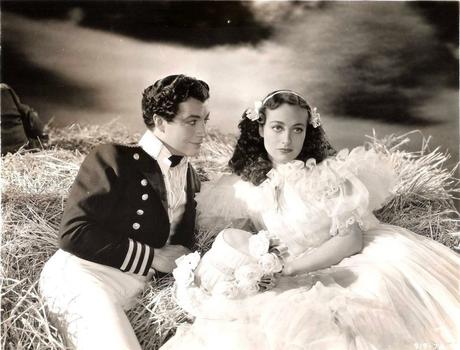
Joan certainly got a change of pace with her next movie, 1936’s The Gorgeous Hussy. The Gorgeous Hussy stands out as one of the more unusual movies in Joan’s filmography. Ever since she shot to stardom in Our Dancing Daughters, she had been known for playing distinctly modern characters. The Gorgeous Hussy ended up being the first and last time Joan starred in a period film. In The Gorgeous Hussy, Joan stars as Peggy O’Neal Eaton, the daughter of an innkeeper who finds herself surrounded by many early American figures, including Andrew Jackson, and becomes the subject of rumors and gossip.
The Gorgeous Hussy isn’t a movie that gets discussed very often today, even in the context of Joan’s career, but MGM had clearly been planning it to be a prestige picture. MGM spent over a million dollars on its production and gave it an A-list cast that also included Robert Taylor, Lionel Barrymore, Beulah Bondi, Franchot Tone, and Melvyn Douglas. (Jimmy Stewart was also part of the cast, but he was still very early in his career at the time.) On top of everything else, they got Clarence Brown to direct. Louis B. Mayer was often doubtful of big-budget prestige pictures, but this one certainly had the starpower to draw audiences in.
While some of MGM’s other prestige pictures from this era were too expensive to be profitable, The Gorgeous Hussy did turn a profit. Critics were largely positive about it, praising the performances, direction, and cinematography. In terms of Joan’s performance, she generally got good marks from the critics. Even though some did note that her modern image seemed out of place in a film set in the nineteenth century, many critics were glad to see Joan in a role where she could do something new and different. In Myrna Loy’s memoir, Being and Becoming, she said that Joan had originally been set to star in Parnell with Clark Gable and she had been set to star in The Last of Mrs. Cheyney with William Powell. But since Parnell was also set in the eighteenth century, the studio switched Myrna and Joan around because of audience reactions to Joan in the Gorgeous Hussy. It’s possible that critics were more receptive to Joan in this part than the general public was.
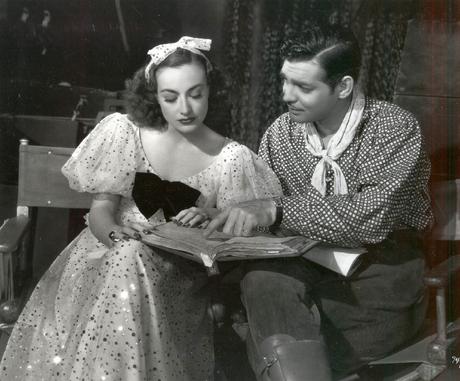
On the other hand, Joan’s second movie of 1936, Love on the Run, was most decidedly a return to more familiar territory. Love on the Run brought her back together with two of her most frequent co-stars: Clark Gable (their seventh movie together) and Franchot Tone (their sixth movie together.) Today, Love on the Run is often regarded as a knockoff of It Happened One Night and not one of the best movies she made with either Gable or Tone. When it was first released, critics generally called it a bit of fun nonsense. Original reviews for the movie often described it with phrases like “thin but amusing,” “a clever bit of tomfoolery,” and “unbelievable but joyous.” Audiences were certainly willing to embrace the nonsense and Love on the Run earned a profit of nearly $1.3 million, making it the most profitable of all the Crawford/Gable movies.
While many critics were willing to look past its flaws, some had a harder time with it. One critic for the New Yorker wrote:
“Everybody works very hard in Love on the Run, but only succeeds in seeming pretty pitiful. The most pitiful people involved are Joan Crawford, Clark Gable, and Franchot Tone. I suppose the studio felt that these three citizens simply had to be kept busy or heaven knows what they’d be up to, and so some sort of sketch was contrived for them.”
Another critic for the New York Times recognized that Love on the Run was perhaps too tried and true, writing, “A slightly daffy cinematic item of no importance, Love on the Run presents Clark Gable, Joan Crawford, and Franchot Tone in roles that by now are a bit stale.”
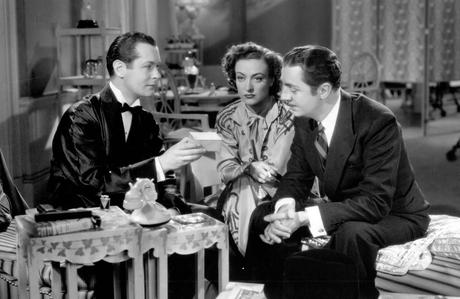
In 1937, MGM released three more Joan Crawford movies, the first of which was The Last of Mrs. Cheyney, based on the 1925 play of the same name. (The play had also been adapted as a film starring Norma Shearer in 1929.) The Last of Mrs. Cheyney wasn’t unprofitable – a cast that included Joan, William Powell, and Robert Montgomery was sure to draw audiences in – but its reviews were considerably more mixed than they had been for Love on the Run and The Gorgeous Hussy. Many critics liked it and thought it was a good update of the source material, but many thought the story was too familiar and suffered from the common stage-to-film adaptation problem of being too talky. A critic for the Hollywood Spectator called it “dead on its feet” and “the most uninteresting piece of screen entertainment I have seen in a long time,” adding, “I understand Metro is thinking of doing more revivals. I hope it will profit from the fact that the smelling salts put under Mrs. Cheyney’s nose to revive her were not quite strong enough.”
A review from the New York Times took the opportunity to speak highly other iterations of the story:
“The recollections Mrs. Cheyney conjures up are pleasing. They recall Ina Claire bringing Mr. Lonsdale’s bright epigrams to Broadway in 1925 and Norma Shearer graciously, even gaily, fleecing a most delightful set of Mayfair victims of sundry baubles for the film in 1929…To this reviewer, Miss Crawford seemed overly arch, and certainly not properly condescending (as Miss Shearer was) toward the gilded victim of her designs.”
Some critics noted that her role wasn’t ideal material for Joan, but still gave her credit for what she brought to the part. The Hollywood Reporter wrote:
“The famous role of Mrs. Cheyney…is not Miss Crawford’s best but she brings a subtle sense of dramatic values and a carefully restrained delivery that bring the character genuinely to life.”
Variety also said of her performance:
“Joan Crawford takes the paper character, pretty synthetic in coming out of the mothballs, and gives it vitality and charm.”
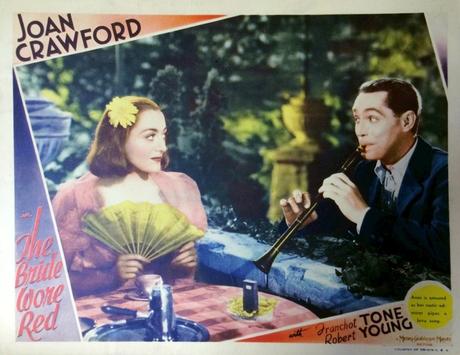
The Last of Mrs. Cheyney gave Joan a chance to venture into a new type of character – jewel thief – but her next movie, The Bride Wore Red, put her back in a more familiar place as a nightclub singer in a Cinderella tale, starring with Franchot Tone for the final time. While movies like The Gorgeous Hussy and Love on the Run were profitable and well-received on their initial release but aren’t fan favorites today, just the opposite is true for The Bride Wore Red. Initial reviews for The Bride Wore Red were largely negative and the movie was a disappointment at the box office, but it has gained some appreciation among Joan’s modern day fans.
To get an idea of how negative critics were about The Bride Wore Red, here is a small selection of original reviews:
“Gowns by Adrian and settings by Cedric Gibbons do not entirely conceal the underlying shabbiness of The Bride Wore Red…Like so many of these cinematic affairs of the heart, the film pretends to a sophistication which the material quite obviously lacks.”
New York Times
“[It] is one of the least entertaining of the current films – ponderous in movement, pedestrian in speech, hackneyed in situation, unimaginative in treatment and altogether unworthy of its fine cast.”
New York World Telegram
“The most admirable characteristics of either Joan Crawford or Franchot Tone are not exactly the type needed to make The Bride Wore Red something charming, light, and delightful.”
The New Yorker
“Joan Crawford, Franchot Tone and Robert Young are [not] lucky with the sententious and confusing Cinderella tale imposed on them.”
Newsweek
“Long on artistic values, elaborate settings, this is short on entertainment…Picture is draggy, altogether too long. It may be improved with more cutting…The picture falls way short of its box office names.”
Philadelphia Exhibitor
“Keenly disappointing as entertainment [it] is also a jolt to those loyal Joan Crawford fans who will expect far more than they receive in the matter of a good performance. The picture drags in story and action, is far too long and has nothing to lift it above mediocrity.”
Variety
“Heaven help the actors on a script like this…Miss Crawford offers a performance both gracious and compelling, but the plot defeats everything.”
Photoplay
The Bride Wore Red was so unpopular that the Motion Picture Herald’s December 18, 1937 issue included a write up of Joan’s third movie of the year, Mannequin, which opened with a sentence advising theater owners to promote Mannequin by letting people know, “it does not resemble The Bride Wore Red in any particular.”
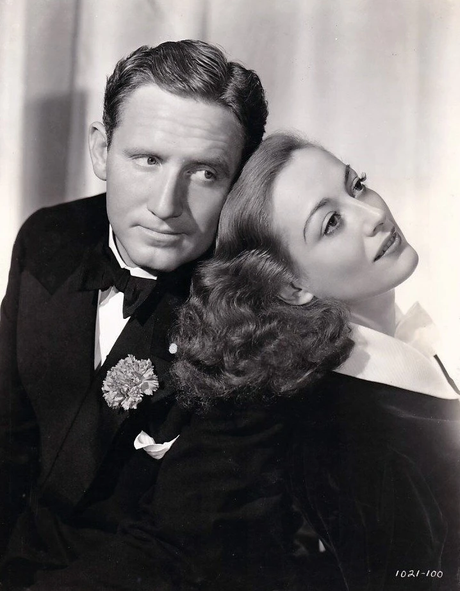
Mannequin was a slight return to form for Joan. Once again, she played a shopgirl. But it was a profitable movie which gave her a good new co-star in Spencer Tracy and marked the first time she worked with director Frank Borzage. And even though many critics called Mannequin the best movie Joan Crawford had done in a while, reviews were a bit mixed but leaned positive overall.
“Take away the dynamic personalities and the sheen and it remains no more than a very familiar screen theme, executed with scarcely any variations…Mannequin has good direction, acting and scenic investiture. All it lacks is a good story. It’s a considerable lack.”
New York Herald Tribune
“[It] is a sleek restatement of an old theme, graced by a superior cast and directed with general skill by Frank Borzage who has a gift for sentiment. All this is more than the story deserved, but about what one expects from an MGM ‘Mannequin’ with Joan Crawford. Call it fair.”
New York Times
“A good cast and Frank Borzage’s imaginative direction fail to impart a minimum of credibility to the story…Chief virtue of the unconvincing tenement-to-penthouse fable that gives Joan Crawford her best recent role.”
Newsweek
“[It] will carry Joan Crawford along without disturbing her present status. It stirs the emotions but makes no deep impression, possibly because the story is a little too self-consciously ‘dramatic.’ It has a favorable prospect for favorable business, especially in the keys. Somewhat depressing in mood, very talky…”
Variety
1938 was a quiet year in Joan’s career. She only appeared in one movie that year, The Shining Hour. But as she headed into the year, it was clear she needed some new professional challenges. Even though nearly all of her movies in the previous few years had been profitable, The Bride Wore Red being the lone exception, actors can only go on playing the same types of characters in the same types of stories for so long – and reviews for her movies had been peppered with comments about her movies being stale or beneath her talents for a while.
Heading into 1938, Joan was carefully considering what her next career move should be and she wasn’t necessarily limiting herself to Hollywood. Her contract with MGM was set to end in July 1938 and she would be free to pursue other options if she wanted to when that time came. Rumors that Joan was interested in doing live theater had been circulating for a while, and by the fall of 1937 and early 1938, those rumors had generated some notable buzz.
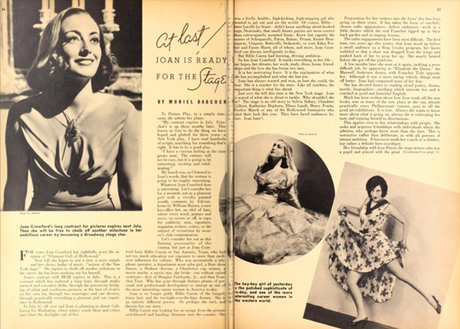
In the November 1936 issue of Picture Play magazine, they published an item which read, “Next year the try-out theaters are going to have Joan Crawford or spend their last nickel trying to get her. Not long ago she confided in a reporter that she would like a stage try-out in some secluded spot.” By September of 1937, rumors about the idea of Joan going on the stage gained enough traction that Picturegoer magazine published an open letter to her in their September 18, 1937 issue, titled “Crawford at the Cross-Roads.” In this letter, they pleaded with Joan to reconsider her stage ambitions – arguing that she had become a fixture in Hollywood, that she could still reach new heights in films if she’s thoughtful about her roles, and warned her to ask Katharine Hepburn about The Lake before making any decisions. In January 1938, movie fans could open up Picture Play magazine and see the headline “At Last! Joan is Ready for the Stage.” Motion Picture magazine also published an article that same month about Joan’s Broadway ambitions that same month, titled “I’ll Do It If It Kills Me!”
In the end, Joan never did appear in live theater outside of the time she spent as a chorus girl before movie stardom. Instead, she signed a new five-year contract with MGM in May 1938. And it does seem like Joan was trying to be selective about her next film. Screenland magazine’s June 1938 issue included an article which mentioned that Joan Crawford had been discarding scripts for the past six months, adding, “At the critical stage of her career, she doesn’t want to pick a bloomer.”
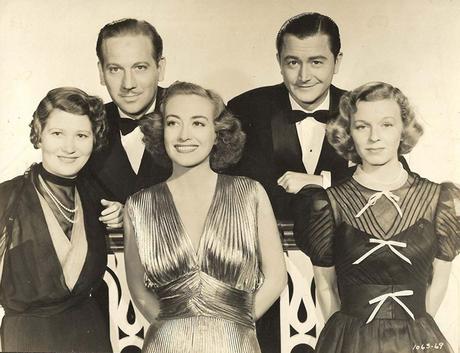
Joan decided to make The Shining Hour after seeing a production of the stage version during a trip to New York. When she returned home, she convinced MGM to purchase the rights to do a film version. The Shining Hour was released in November 1938, six months after the publication of the Box Office Poison ad, and included Margaret Sullivan, Melvyn Douglas, and Fay Bainter as her co-stars. She also had another chance to be directed by Frank Borzage. While The Shining Hour turned a profit of $299,000 for MGM, reviews were, once again, mixed. A review by Bosley Crowther published in the New York Times described it in a way that had become a recurring theme in reviews of Joan’s movies from this era – that an all-star cast and great costumes and sets can’t disguise a weak story:
“The presence of a star-studded cast…the directorial talents of Frank Borzage and the elegancies of dress and set as designed by Adrian and Cedric Gibbons fail to disguise a hackneyed story of a definitely inferior grade.”
A critic for the New York Herald Tribune thought The Shining Hour lost something in translation from the play it was based on:
“Keith Winter’s telling domestic tragedy of life in rural England has gone through the cinema’s wringer with a loss of its English garments, its tragedy, and some of its point.”
A review published in the December 1938 issue of Motion Picture Reviews magazine was more favorable, declaring, “There is something new under the sun, for “The Shining Hour” gives us Miss Crawford surrounded by a play instead of a play surrounded by Miss Crawford” This same review was also positive about the performances of Joan, Margaret Sullivan, and Fay Bainter, but did note that the formula of a working class girl being brought into high society was a typical formula for Joan Crawford movies.
Even though The Shining Hour was released six months after the publication of the Box Office Poison ad, the November 19, 1938 issue of the Motion Picture Herald recommended that theater owners remind customers that Joan Crawford had frequently been included in annual lists of box office champions when marketing the movie.
Since Joan had a new contract with MGM, she still had a few more years left at the studio. But by this point in time, MGM was more interested in building up a new roster of stars. Mickey Rooney wasn’t exactly a newcomer to MGM, but he was just getting started with the Andy Hardy movies. Judy Garland was on her way up and it wouldn’t be long before The Wizard of Oz hit theaters. Lana Turner’s career was gaining momentum. Greer Garson’s turn as one of the great movie queens of the 1940s was right around the corner. Despite being one of MGM’s biggest icons, Joan’s career was simply no longer being given the kind of attention it needed.
For more context on Joan’s later years at MGM, let’s talk about Myrna Loy for a moment. Myrna parted ways with MGM a few years after Joan did, and she was all too aware of what it was like to feel expendable to studios as they prioritized new talent over giving established stars a chance to grow. She wrote about this in her memoir, and while it’s about her personal decision to leave MGM, her treatment by the studio wasn’t exactly a unique experience. In fact, MGM’s treatment of Joan near the end of her time with the studio and her eventual transition to Warner Brothers heavily influenced Myrna’s decision to leave:
“After thirteen years at MGM, I was resolved to get out of our contract a year before it expired. Of course, my great days took place there to a great extent – they certainly did well by me – but I had the feeling Joan Crawford had when she finally left after eighteen years: that I would just be drowned, that they wouldn’t go out of their way to find material, and so forth. I wanted to get out before they finished me off. They used to do that in the studios – they’d either get very careless or do it deliberately. Somebody new comes along, they get all excited, and all their interest goes there. Even if you’re still bringing in the shekels at the box office, they have a tendency to ignore you. They were pushing another redhead, Greer Garson, and deservedly so, but they were also bringing in stars who did my sort of thing – Claudette Colbert, Katharine Hepburn, Irene Dunne – and giving them roles that should have been offered to me. Admittedly my wartime hiatus had probably diminished my market value and created some animosity at the top. Nick Schenck, for example, kept telling them at the studio that I didn’t want to work.
Metro’s other female stars of the thirties – Garbo, Norma Shearer, Eleanor Powell, Jeanette MacDonald, and Joan – had already gone. The studio just didn’t know what to do with us, Joan especially. We all knew that they were easing her onto the skids, and I was always cheering her for going out to Warners, making Mildred Pierce, and beginning a whole new career. You see, they had set ideas about her; they still thought of her as a jazzy girl. They had set ideas about all of us, forgetting that we had aged a bit and might be able to extend our range. We were stuck with our images. Sometimes they lacked imagination…Metro wanted to keep me available for an occasional Thin Man or marital farce with Bill. Otherwise, I didn’t exist.”
As someone who had so deeply embraced her movie star status, being called “box office poison” unquestionably had to be a very painful blow to Joan. Even though most of her movies since 1935 had actually been profitable, her career had clearly stagnated and MGM wasn’t doing much to help. Instead of helping her find a project that would challenge her skills as an actress and help her transcend the “box office poison” label, she ended up in Ice Follies of 1939.
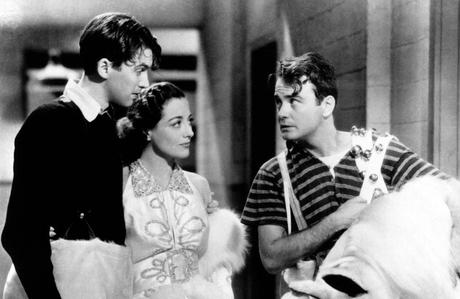
Ice Follies of 1939 is another one of the more unusual movies of Joan’s career and it did her no favors professionally. It lost $343,000 at the box office and critics, at times, seemed rather baffled by it. There was some enthusiasm for the skating sequences, but the Hollywood Reporter wrote:
“Ice Follies defies identification in any of the accepted categories. Its story thread is not of the musical comedy school, for here you are asked to take it with the utmost seriousness then to widen your scope of vision to embrace appended ice spectacles, which completely obscure the principles and underlying story.”
A review in Screenland magazine’s June 1939 issue questioned if it would appeal to anyone besides dedicated Joan Crawford fans and ice skating enthusiasts and even the reviewer said they were still deciding if they liked it or not. Variety was glad to see Joan back in a lighthearted role, but some fans were disappointed that Joan didn’t skate in it and Motion Picture Reviews magazine noted that her part seemed secondary. One of the more scathing reviews was in National Box Office Digest, which noted the potential draw of the skating sequences before adding:
“Having said that, we are compelled to report that it will not do anybody concerned with its making any good. Except the fellow who made the ice. Exhibitors will be interested in knowing what it does for Joan Crawford who has been killing herself off fast at the box office. We can report that it does the best job in a long time in that respect, because she plays a part that could have just as well been played by a stock girl – except that a stock girl would not have been allowed to make some of the close-up speeches that Crawford does in this one.”
Joan’s second movie of 1939, The Women, was much more successful. Joan knew the part of Crystal Allen was a good role in a good movie. Even if it wasn’t a lead and wasn’t a sympathetic character, Joan knew it was a good opportunity and she fought to get the part. If Joan was being put onto the skids, like Myrna Loy said, Joan was determined to hold on and speak up for the parts she wanted, even if Louis B. Mayer thought they would be a bad career move.
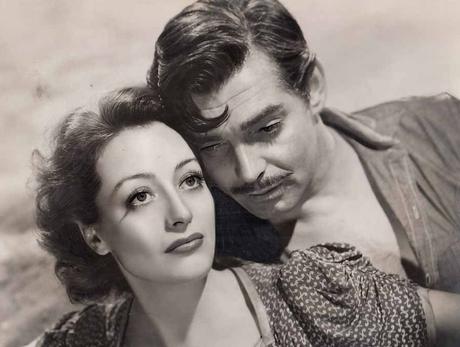
Throughout 1940 and 1941, Joan appeared in some more daring films. In Strange Cargo, she was re-teamed with Clark Gable for the last time, but the movie ended up being rather controversial. It had many issues with censorship and while its reviews were generally favorable, they often included adjectives like “weird” and acknowledged that it’s not going to be everyone’s cup of tea. Despite that, Strange Cargo did earn a small profit. Strange Cargo was followed by Susan and God, another movie Joan asked to do. Even though a lot of the original press for Susan and God was positive, it ended up losing $433,000.
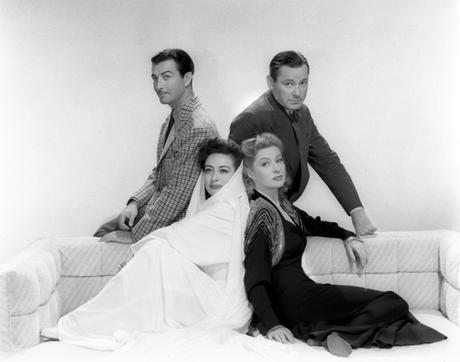
Next up in 1941 was A Woman’s Face. Louis B. Mayer tried to talk her out of playing a character with a prominent facial scar, but Joan went for it anyway and got some positive reviews for taking on a bold, new type of role. Her second movie of 1941, When Ladies Meet, was another film where Joan got to be part of an all-star cast. She was reunited with Robert Taylor, but this time, the cast also included MGM’s big new star, Greer Garson – already a two-time Academy Award nominee and about to star in Mrs. Miniver. If you’re looking for a movie that reflects MGM at this transitional period, you’d be hard pressed to do better than When Ladies Meet, a remake of a movie MGM did in 1933 that stars both one of their biggest female stars of the 1930s and one of their biggest female stars of the 1940s. When Ladies Meet was a critical and box office success, earning a profit of $607,000 and lots of positive reviews for both Joan and Greer, but Robert Taylor got some notes for stealing his scenes.
1942 and 1943 marked Joan’s final two years with MGM, although she briefly headed over to Columbia studios to star in They All Kissed the Bride, which had been originally planned for Carole Lombard before she was killed in a plane crash. Her only MGM movie for 1941 was Reunion in France, which gave her the unexpected co-star of John Wayne. The movie was a financial success, but Joan was later quoted as saying, “If there is an afterlife and I am to be punished for my sins, this is one of the pictures they’ll make me see over and over again. John Wayne and I both went down for the count, not just because of a silly script but because we were so mismatched. Get John out of the saddle and you’ve got trouble.”
Joan’s last film for MGM (until 1953’s Torch Song) was Above Suspicion with Fred MacMurray, which received middling reviews from the critics.
If MGM wasn’t willing to give Joan’s career the attention it needed, she was willing to see what Warner Brothers could do for her. She signed a three-film contract with Warner Brothers in 1943. With that new contract, Joan took her time to make sure her next movie was a winner. Aside from making a cameo appearance in 1944’s Hollywood Canteen, she kept a low profile until Mildred Pierce was released in 1945, successfully launching a new era in her career and winning an Academy Award for her performance.
